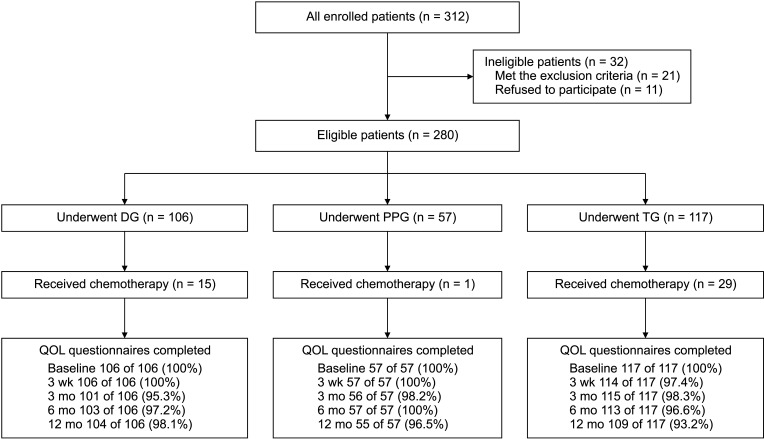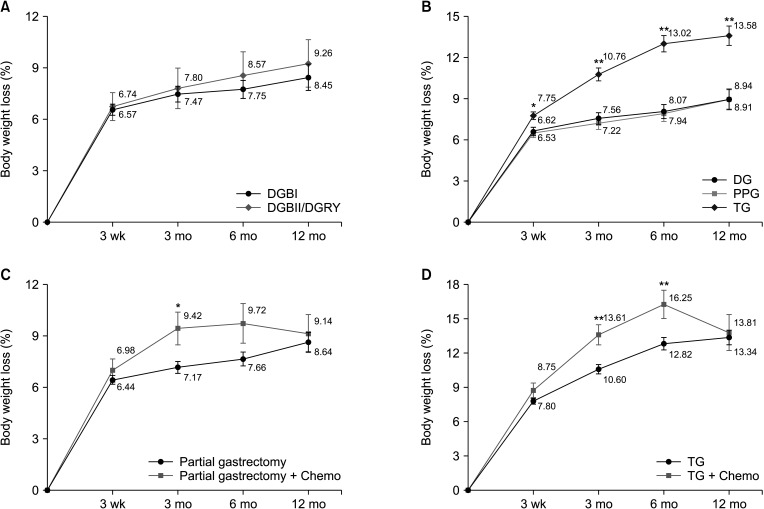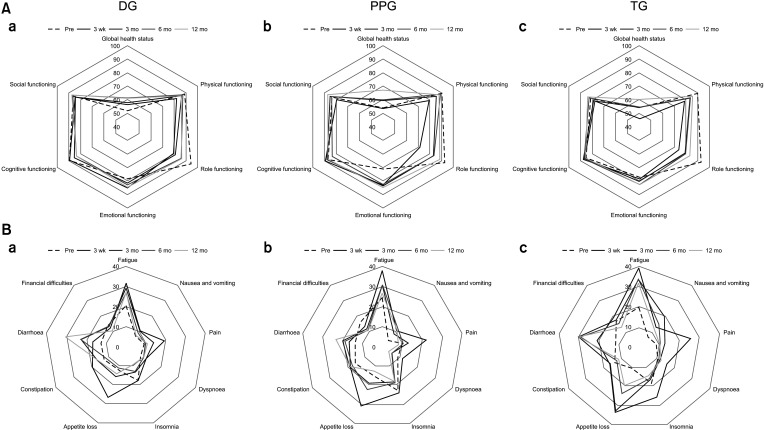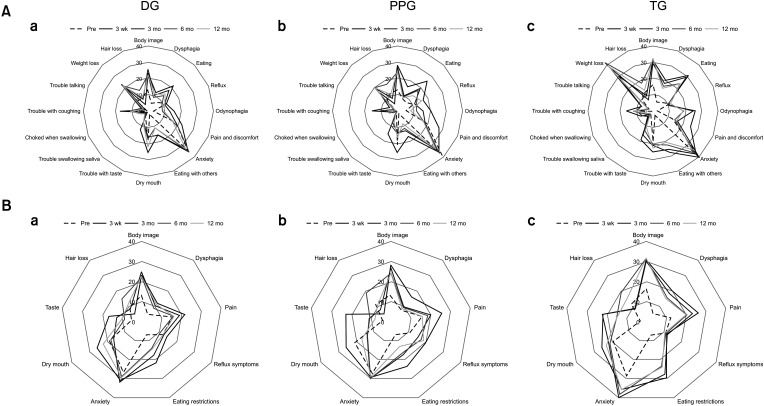Ann Surg Treat Res.
2022 Jul;103(1):19-31. 10.4174/astr.2022.103.1.19.
Postoperative quality of life after gastrectomy in gastric cancer patients: a prospective longitudinal observation study
- Affiliations
-
- 1Department of Surgery, Seoul National University Hospital, Seoul, Korea
- 2Department of Gastrointestinal Surgery, Ren Ji Hospital, School of Medicine, Shanghai Jiao Tong University, Shanghai, China
- 3Department of Surgery, Seoul National University Bundang Hospital, Seongnam, Korea
- 4Cancer Research Institute, Seoul National University, Seoul, Korea
- 5Department of Surgery, Gachon University Gil Medical Center, Incheon, Korea
- 6Division of Foregut Surgery, Department of Surgery, Korea University Anam Hospital, Korea University College of Medicine, Seoul, Korea
- 7Department of Surgery, Eulji University, Seoul, Korea
- 8Department of Surgery, Al-Noor Specialist Hospital, Makkah, Saudi Arabia
- 9Department of Surgery, Taif University, College of Medicine, Taif, Saudi Arabia
- KMID: 2531144
- DOI: http://doi.org/10.4174/astr.2022.103.1.19
Abstract
- Purpose
The European Organization for Research and Treatment of Cancer quality of life (QOL) questionnaires (QLQ-C30, QLQ-OG25, and QLQ-STO22) are widely used for the assessment of gastric cancer patients. This study aimed to use these questionnaires to evaluate QOL in postgastrectomy patients.
Methods
We prospectively evaluated 106 patients with distal gastrectomy (DG), 57 with pylorus-preserving gastrectomy (PPG), and 117 with total gastrectomy (TG). Body weight and QOL questionnaires were evaluated preoperatively and postoperatively (at 3 weeks, and 3, 6, and 12 months).
Results
TG patients had significantly more weight loss than DG/PPG patients. Compared with DG, patients after PPG had less dyspnea (P = 0.008) and trouble with coughing (P = 0.049), but more severe symptoms of insomnia (P = 0.037) and reflux (P = 0.030) at postoperative 12 months. Compared with DG/PPG, TG was associated with worse body image, dysphagia, eating, and taste in both OG25 and STO22. Moreover, OG25 revealed worse QOL in the TG group with respect to odynophagia, eating with others, choked when swallowing, trouble talking, and weight loss. The QOL of patients who received chemotherapy was worse than those in the chemo-free group in both physical functioning and symptoms such as nausea/vomiting, appetite loss, and trouble with taste; however, these side effects would soon disappear after finishing chemotherapy.
Conclusion
PPG was similar to DG in terms of postoperative QOL and maintaining body weight, while TG was always inferior to both DG and PPG. Adjuvant chemotherapy can affect both body weight and QOL despite being reversible.
Keyword
Figure
Reference
-
1. Jun JK, Choi KS, Lee HY, Suh M, Park B, Song SH, et al. Effectiveness of the Korean National Cancer Screening Program in reducing gastric cancer mortality. Gastroenterology. 2017; 152:1319–1328. PMID: 28147224.
Article2. Aaronson NK, Ahmedzai S, Bergman B, Bullinger M, Cull A, Duez NJ, et al. The European Organization for Research and Treatment of Cancer QLQ-C30: a quality-of-life instrument for use in international clinical trials in oncology. J Natl Cancer Inst. 1993; 85:365–376. PMID: 8433390.
Article3. Husson O, de Rooij BH, Kieffer J, Oerlemans S, Mols F, Aaronson NK, et al. The EORTC QLQ-C30 Summary Score as prognostic factor for survival of patients with cancer in the “real-world”: results from the population-based PROFILES Registry. Oncologist. 2020; 25:e722–e732. PMID: 32297435.
Article4. Bae JM, Kim S, Kim YW, Ryu KW, Lee JH, Noh JH, et al. Health-related quality of life among disease-free stomach cancer survivors in Korea. Qual Life Res. 2006; 15:1587–1596. PMID: 17036253.
Article5. Blazeby JM, Conroy T, Bottomley A, Vickery C, Arraras J, Sezer O, et al. Clinical and psychometric validation of a questionnaire module, the EORTC QLQ-STO 22, to assess quality of life in patients with gastric cancer. Eur J Cancer. 2004; 40:2260–2268. PMID: 15454251.
Article6. Lagergren P, Fayers P, Conroy T, Stein HJ, Sezer O, Hardwick R, et al. Clinical and psychometric validation of a questionnaire module, the EORTC QLQ-OG25, to assess health-related quality of life in patients with cancer of the oesophagus, the oesophago-gastric junction and the stomach. Eur J Cancer. 2007; 43:2066–2073. PMID: 17702567.
Article7. Yun YH, Park YS, Lee ES, Bang SM, Heo DS, Park SY, et al. Validation of the Korean version of the EORTC QLQ-C30. Qual Life Res. 2004; 13:863–868. PMID: 15129896.
Article8. Lee JH, Lee HJ, Choi YS, Kim TH, Huh YJ, Suh YS, et al. Postoperative quality of life after total gastrectomy compared with partial gastrectomy: longitudinal evaluation by European Organization for Research and Treatment of Cancer-OG25 and STO22. J Gastric Cancer. 2016; 16:230–239. PMID: 28053809.
Article9. Lee SS, Chung HY, Kwon OK, Yu W. Long-term quality of life after distal subtotal and total gastrectomy: symptom- and behavior-oriented consequences. Ann Surg. 2016; 263:738–744. PMID: 26501699.10. Namikawa T, Munekage E, Munekage M, Maeda H, Kitagawa H, Nagata Y, et al. Reconstruction with jejunal pouch after gastrectomy for gastric cancer. Am Surg. 2016; 82:510–517. PMID: 27305882.
Article11. Takahashi M, Terashima M, Kawahira H, Nagai E, Uenosono Y, Kinami S, et al. Quality of life after total vs distal gastrectomy with Roux-en-Y reconstruction: use of the Postgastrectomy Syndrome Assessment Scale-45. World J Gastroenterol. 2017; 23:2068–2076. PMID: 28373774.
Article12. Inada T, Yoshida M, Ikeda M, Yumiba T, Matsumoto H, Takagane A, et al. Evaluation of QOL after proximal gastrectomy using a newly developed assessment scale (PGSAS-45). World J Surg. 2014; 38:3152–3162. PMID: 25135173.
Article13. Liu XF, Gao ZM, Wang RY, Wang PL, Li K, Gao S. Comparison of Billroth I, Billroth II, and Roux-en-Y reconstructions after distal gastrectomy according to functional recovery: a meta-analysis. Eur Rev Med Pharmacol Sci. 2019; 23:7532–7542. PMID: 31539143.14. Nakamura M, Nakamori M, Ojima T, Iwahashi M, Horiuchi T, Kobayashi Y, et al. Randomized clinical trial comparing long-term quality of life for Billroth I versus Roux-en-Y reconstruction after distal gastrectomy for gastric cancer. Br J Surg. 2016; 103:337–347. PMID: 26840944.
Article15. Tomikawa M, Korenaga D, Akahoshi T, Kohshi K, Sugimachi K, Nagao Y, et al. Quality of life after laparoscopy-assisted pylorus-preserving gastrectomy: an evaluation using a questionnaire mailed to the patients. Surg Today. 2012; 42:625–632. PMID: 22527179.
Article16. Huang C, Yu F, Zhao G, Xia X. Postoperative quality of life after laparoscopy-assisted pylorus-preserving gastrectomy compared with laparoscopy-assisted distal gastrectomy for early gastric cancer. J Gastroenterol Hepatol. 2020; 35:1712–1719. PMID: 31945189.
Article17. Guideline Committee of the Korean Gastric Cancer Association (KGCA). Development Working Group & Review Panel. Korean Practice Guideline for Gastric Cancer 2018: an evidence-based, multi-disciplinary approach. J Gastric Cancer. 2019; 19:1–48. PMID: 30944757.18. Choi JH, Han SU, Yang HK, Kim YW, Ryu KW, Park JM, et al. The pattern of postoperative quality of life following minimally invasive gastrectomy for gastric cancer: a prospective cohort from Korean multicenter robotic gastrectomy trial. Ann Surg Treat Res. 2020; 99:275–284. PMID: 33163457.
Article19. Park KB, Yu B, Park JY, Kwon OK, Yu W. Impact of body mass index on quality of life after distal gastrectomy for gastric cancer. Ann Surg Treat Res. 2019; 96:250–258. PMID: 31073515.
Article20. Park JH, Kim E, Seol EM, Kong SH, Park DJ, Yang HK, et al. Prediction model for screening patients at risk of malnutrition after gastric cancer surgery. Ann Surg Oncol. 2021; 28:4471–4481. PMID: 33481124.
Article21. Park DJ, Kim YW, Yang HK, Ryu KW, Han SU, Kim HH, et al. Short-term outcomes of a multicentre randomized clinical trial comparing laparoscopic pylorus-preserving gastrectomy with laparoscopic distal gastrectomy for gastric cancer (the KLASS-04 trial). Br J Surg. 2021; 108:1043–1049. PMID: 34487147.
Article22. Suh YS, Han DS, Kong SH, Kwon S, Shin CI, Kim WH, et al. Laparoscopy-assisted pylorus-preserving gastrectomy is better than laparoscopy-assisted distal gastrectomy for middle-third early gastric cancer. Ann Surg. 2014; 259:485–493. PMID: 23652333.
Article23. Hosoda K, Yamashita K, Sakuramoto S, Katada N, Moriya H, Mieno H, et al. Postoperative quality of life after laparoscopy-assisted pylorus-preserving gastrectomy compared with laparoscopy-assisted distal gastrectomy: a cross-sectional postal questionnaire survey. Am J Surg. 2017; 213:763–770. PMID: 27751530.
Article24. Eom BW, Park B, Yoon HM, Ryu KW, Kim YW. Laparoscopy-assisted pylorus-preserving gastrectomy for early gastric cancer: a retrospective study of long-term functional outcomes and quality of life. World J Gastroenterol. 2019; 25:5494–5504. PMID: 31576095.
Article25. Zhu CC, Kim TH, Berlth F, Park SH, Suh YS, Kong SH, et al. Clinical outcomes of intraoperative manual dilatation of pylorus in pylorus-preserving gastrectomy: a retrospective analysis. Gastric Cancer. 2018; 21:864–870. PMID: 29536295.
Article26. Lewandowska A, Rudzki G, Lewandowski T, Próchnicki M, Rudzki S, Laskowska B, et al. Quality of life of cancer patients treated with chemotherapy. Int J Environ Res Public Health. 2020; 17:6938.
Article27. Noordman BJ, Verdam MG, Lagarde SM, Shapiro J, Hulshof MC, van Berge Henegouwen MI, et al. Impact of neoadjuvant chemoradiotherapy on health-related quality of life in long-term survivors of esophageal or junctional cancer: results from the randomized CROSS trial. Ann Oncol. 2018; 29:445–451. PMID: 29126244.
Article28. van der Valk MJ, Hilling DE, Meershoek-Klein Kranenbarg E, Peeters KC, Kapiteijn E, Tsonaka R, et al. Quality of life after curative resection for rectal cancer in patients treated with adjuvant chemotherapy compared with observation: results of the Randomized Phase III SCRIPT Trial. Dis Colon Rectum. 2019; 62:711–720. PMID: 30870225.
Article
- Full Text Links
- Actions
-
Cited
- CITED
-
- Close
- Share
- Similar articles
-
- Prospective Multicenter Observational Study on Postoperative Quality of Life According to Type of Gastrectomy for Gastric Cancer
- A Study of the Quality of Life Following after Curative Surgery for Gastric Cancer
- Quality of life after total gastrectomy in the gastric cancer patients
- Quality of Life after Curative Surgery in Patients with Gastric Cancer: Comparison between a Subtotal Gastrectomy and a Total Gastrectomy
- Quality of Life of Long-term Survivors after a Subtotal or a Total Gastrectomy for Gastric Cancer





